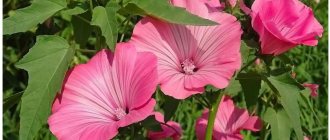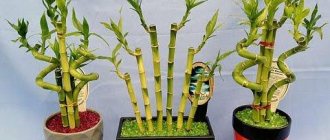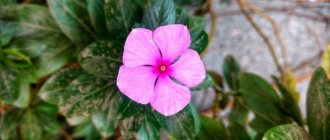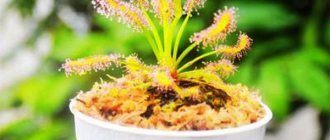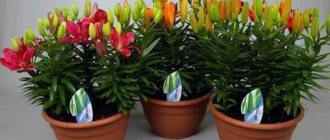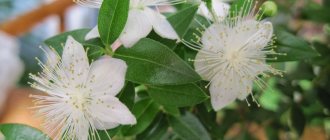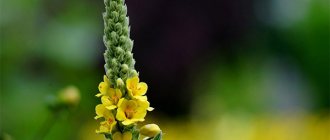Description of cotton
Cotton is a whole botanical series from the Malvaceae family, which includes about 50 species of plants, woody and herbaceous, annuals and perennials. Cotton plants, which serve as raw materials for the textile industry, are annual or biennial herbaceous plants.
Features of cultivated cotton:
- Root. Tap root system. The length of the root can reach 3 meters.
- Stem. Ramified. Reaches a height of 2 m.
- Leaves. Arranged alternately, fastened with petioles. They have a lobed shape - each leaf has from 3 to 5 lobes. Similar to maple.
- Flowers. Yellow, white or red, with 3-5 petals.
When the plant blooms, it is all covered with flowers. When flowering is completed, an unusual fruit appears in place of each flower - a round or oval-shaped box. Inside this “chest” the cotton seeds ripen.
When the seeds ripen, the capsule bursts and, opening, reveals a white fibrous mass in which the seeds of the plant are hidden. This white mass is called cotton. It consists of short and long hairs. The first ones are fleecy, the second ones are fluffy.
Story
People began to use the fruits of cotton many centuries ago. Archaeological excavations testify to this. The first people to use cotton were in India. Here, archaeologists found materials and tools with which cotton raw materials were processed.
Somewhat later, cotton began to be grown in Greece and the countries of the Middle East. China, Persia, Mexico, Peru - in all these countries cotton began to be cultivated several thousand years BC.
The British were the first in Europe to produce cotton fabrics. The first machines for processing cotton appeared here in the 1770s.
Statistics say that every earthling consumes 7 kg of cotton annually.
Thanks to the development of technology, cotton production has become cheaper and the range of fabrics has expanded. The range of cotton products includes dozens of fabrics - calico, pique, gauze, cambric, poplin and many others.
Cotton and handmade
Hand-made cotton flowers are widely popular in such types of handicrafts as scrapbooking and cardmaking . They fit perfectly into flower arrangements and decorative wreaths.
Also works in country, eco, etc. styles. Such flowers can be made quite simply and economically.
Required materials and tools
For manufacturing you will need the following materials :
- cardboard egg tray;
- brown paint;
- brown threads;
- sewing needle;
- brush;
- scissors;
- cotton wool or synthetic winterizer;
- hot melt adhesive.
In general, one flower takes no more than ten minutes, not counting the time required for the paint to dry.
What types and varieties are there?
For a long time, botanists were unable to classify numerous representatives of the Cotton genus. There are many species, and most of them are very variable under the influence of external factors. And most importantly, cotton plants are easily pollinated, resulting in hybrids.
Agriculture today uses the following types of cotton:
- Grassy. Annual plant. Distribution area: Central and Southeast Asia, Transcaucasia. The shortest and most persistent species. It endures advancement to the north better than others. Coarse and short cotton is obtained from the herbaceous cotton plant; it is also called woolly.
- Indo-Chinese. Tree-like perennial plant. The tallest species. Its height can reach 6 m. Unlike other species, it has red flowers, not yellow. But the color of the resulting cotton is yellow. Habitat: tropical regions.
- Peruvian. Produces the longest and highest quality fiber. At first it was a perennial plant, but after selection it became an annual plant. It is grown only in Egypt and on the southeast coast of the United States.
- Ordinary. Received the greatest distribution. It is grown wherever the climate allows. This is an annual plant with white flowers. The resulting fiber is of average quality.
Varieties that have become widespread in Central Asia are Tashkent-6, Andijon-35, Regar-34, Dashoguz-11 and others.
We also recommend watching a story about a breakthrough in the field of agricultural selection - obtaining a new type of cotton:
Growing Requirements
When growing cotton, its requirements for the following factors are taken into account:
- Sowing time. Cotton seeds should be sown as early as possible - no later than February. If you delay, the plant will bloom too late; the boxes will ripen only in late autumn.
- Temperature. All types of cultivated cotton are extremely thermophilic. Seed germination begins at a temperature of 10-12°C. The optimal temperature is 25-30°C. The plant dies at frosts of 1-2°C. Moreover, death can occur both in the spring - at the beginning of the growing season, and in the autumn.
- Moisture. Cotton plants tolerate drought well thanks to their developed root system. The plant grows without moisture, but there is no talk of high yields. Cotton plants need irrigation. If there is not enough moisture, the boxes fall to the ground.
- Light. The plant is light-loving.
- The soil. Prefers grey-earth, alkaline-marsh soils and saline soils.
- Nutrients. The plant is very demanding regarding fertilizers. To produce 30-35 quintals of raw material per hectare, cotton takes 46 kg of nitrogen, 18 kg of potassium and 16 kg of phosphorus from the soil.
The growing season of cotton grown in Central Asia is about 140 days. And the boxes themselves ripen on the plant for 50 days.
Crop rotation
The best predecessor for cotton is alfalfa. This culture promotes the accumulation of humus, enriches the soil with nitrogen and other useful substances, and reduces the level of salts. Thanks to planting alfalfa, the drainage characteristics of the soil are improved, and air circulates more actively in its upper layer.
Nursery data shows that alfalfa can increase yields by 50%. Moreover, high yields persist for 2-3 years after planting alfalfa.
A multi-field system looks something like this. Of the 6-7 fields prepared for planting cotton, they are used for alfalfa. In addition to alfalfa, it is recommended to plant before cotton:
- corn for silage and green fodder;
- sugar beets;
- any legumes and grains.
Soil preparation
Preparing the soil for cotton comes down to the following activities:
- Peeling the soil after harvesting alfalfa. Completion date: end of August - beginning of September. The plow's recess is small - only 5-6 cm, if the soil is heavy - 10 cm. It is necessary to peel the soil to remove weeds and seeds.
- Plowing the plowed land. The plowshares of a two-tier plow are used to cultivate the soil 40 cm deep.
- Herbicides can be applied simultaneously with plowing. The technique in which the weed is burned along with the rhizome is used extremely rarely.
- Washing of saline soils. Saline soils must be loosened again using a cultivator or plow.
- Double-track harrowing. This event marks the beginning of spring work. In areas with a mild climate, harrowing begins in the second ten days of February.
- Application of manure. This is necessary for weak soils. After application - plowing.
- Cultivation to a depth of 5-8 cm is the final stage of soil preparation.
Cotton plants need a lot of nutrients. If it is grown for many years in one field, it is necessary to apply fertilizers:
- nitrogen – 140-160 kg/ha;
- phosphorus – 80-100 kg/ha;
- potash - 30-50 kg/ha.
If cotton is sown after alfalfa, then in the first 2 years less nitrogen fertilizers can be applied - only 50-70 kg/ha.
The following activities have a good effect:
- Parallel application of mineral and organic fertilizers.
- Stubble crops of “green fertilizers” - cotton yields after them increase by 6-7 c/ha.
- Granulated superphosphate or nitrophoska - 100 kg/ha.
Seed preparation
For sowing, only high-quality, conditioned seeds collected before the onset of frost are used. To obtain stable yields, only zoned cotton should be planted.
Seeds for planting are subjected to mechanical or chemical treatment. The down is mechanically removed - completely or partially. The chemical method involves etching with acid vapors - sulfuric or hydrochloric.
Other preparatory activities:
- Keeping seeds outdoors. Duration of exposure – 30-30 days.
- Seed disinfection. Fentiuram 65% or copper trichlorophenolate is used. Dosage – 12 kg per 1 ton.
- Before sowing, the seeds are immersed in water for 10 hours. Or you can simply moisten them by treating them three times every 10 hours. The water consumption rate is 500 liters per ton of seeds.
Cotton care
Caring for garden or indoor cotton plants is not that difficult. The plant must be watered, fertilized, and fluffed up the soil in a timely manner (in extreme heat, it is recommended to additionally spray it with a spray bottle).
Lighting
Cotton is a photophilous plant. In the shade it grows poorly and hardly develops. When it comes to growing it in the garden, open and well-lit meadows are chosen. If the cotton plant is grown as an indoor flower, western or eastern window sills are chosen for it.
Temperature
The cotton plant loves warmth. Its seeds germinate only at an air temperature of +10 degrees above zero. And the optimal temperature for growing it is 25-30 degrees Celsius.
Attention: even with a slight frost of -1-2 degrees below zero, the cotton plant dies immediately. Therefore, it is sown only when the threat of spring frost has passed.
Moisture content of cotton
Cotton loves average humidity, although this plant copes well with drought. Without sufficient moisture, it does not produce high yields. Additionally (if the weather is too hot and dry), the plant needs irrigation. Otherwise, its flowers and fruits will simply fall off.
Important: when watering cotton, it is important to ensure that moisture does not stagnate in the soil.
Watering
How to water cotton? Despite the fact that this plant is drought-resistant, fruit ripening and abundant flowering in the garden can only be achieved with good watering. This plant is watered in different ways, including sprinkling.
In principle, it is enough to water cotton:
- when 3-5 leaves appear on seedlings;
- three weeks after the first watering;
- during the budding period;
- a week before the leaves fall.
Attention: during flowering and fruiting, cotton needs a lot of moisture.
Priming
The soil for cotton should be alkali-marsh, saline and grey-earth. When planting a plant in open ground, the soil is prepared in August - September. The depth of soil cultivation changes every year. This will prevent further plant diseases.
Circumcision
Cotton does not need pruning.
Top dressing
Cotton is fed as follows:
- before sowing, a small dose of superphosphate is added to the soil;
- During the formation of leaves, flowers and buds, cotton is fed with potassium and phosphorus.
Attention: a lack of phosphorus in the soil causes the plant to develop slowly. Its root system becomes weak, and red veins appear on the leaves. With a lack of potassium, brown spots appear on the leaves. Then the leaves curl and fall off.
Cotton transplant
If we are talking about growing cotton as a houseplant, then replant it as it grows (for example, when the pot for it becomes small). In this case, it is recommended to use the transshipment method in order to reduce the damage to the root system.
Attention: since cotton has too long roots, choose a deep pot for it.
Reproduction
Cotton propagation is carried out by seed. Seeds are sown in open ground only after the threat of spring frosts. For this purpose, high-quality, conditioned seeds are selected, collected before the first frost.
Seeds are subjected to chemical or mechanical treatment before planting. The down in them is removed mechanically (in whole or in part). Chemical - seeds are pickled with sulfuric or hydrochloric acid. Then the seeds are kept in the fresh open air for a month, disinfected, and just before sowing they are immersed in water for 10 hours.
If we are talking about growing cotton by seedlings, then sowing is carried out in January - February. This is done immediately in the greenhouse. The seeds are buried to a depth of 1 cm.
Tip: germination of cotton seeds in a greenhouse is carried out at an air temperature of +24 degrees Celsius.
With the right approach, the first shoots will appear within a few days. During this period, seedlings need to be provided with a large amount of moisture.
Landing rules
The minimum temperature for planting seeds is 10-12°C. Until the earth warms up, there is no point in sowing. Cotton seeds may die in cold soil. Seeds are sown in accordance with the selected planting scheme. But with any option, the row spacing is 60 cm. Schemes used for sowing cotton:
- Dotted method – 60x25 cm.
- Rectangular-nested – 60x45 cm.
- Square-nested – 60x60 cm.
- Wide-row crops – 90x15/20/30 cm.
The parameters of the sowing scheme affect the yield. The use of special methods can increase productivity. Thus, the use of the ridge method allows you to obtain an additional “increase” in the yield - 3 c/ha.
You need to place 2-3 seeds in one hole. They are buried by 4-5 cm. This is for ordinary gray soil, for swamp and meadow soil - 3-4 cm.
Seed consumption is determined by the chosen planting method. The selection is carried out so that there is no need to thin out the plantings. Seeding rates depend on seed treatment:
- Bare seeds – 40-42 kg/ha.
- Hairy seeds – 60 kg/ha.
The number of plants per 1 hectare is 80-120 thousand.
Cotton - denim flower
Popularly, cotton is often called the denim plant, since it is from it that everyone’s favorite denim fabric is made.
The advantages of such fabric are strength, wear resistance, comfort and breathability. The quality of denim directly depends on the cotton from which it is made.
Thus, Mexican cotton with fibers twenty-four millimeters long allows us to produce high-quality denim that has virtually no scars. Fabrics made from Barbados cotton are very soft and durable.
However, it is quite difficult to process and assemble it, so the number of jeans made from such fabric on the modern market is small - about seven percent.
Fabrics made from Zimbabwean cotton are of high quality at an inexpensive cost. The most popular in use is fabric made from Asian and Indian cotton with short staple fiber.
Such jeans occupy up to half of the modern clothing market.
Thus, denim fabrics are quite diverse both in composition, manufacturing method and appearance. It is this variety of choice that has made denim clothing so popular over the years.
Denim also has its own varieties, where cotton is the priority
It is unlikely that in the world you can find things more comfortable and practical than denim.
Plant care
When cotton is sown, you need to provide the crops with care:
- Irrigation. You can water the crops in any way, including sprinkling. In order for the roots to strengthen, it is necessary to water the planting twice. First, when 3-5 leaves appear, the second time - after 3 weeks, when budding begins. When plants flower and bear fruit, they require more moisture. The final watering is a week before the leaves fall off.
- Cultivation. During the growing season, three cultivations are carried out: when seedlings appear, the depth is 8-10 cm;
- before the first watering;
- when the soil dries out.
Cotton in floristry
First of all, when we hear about cotton, clothes, towels, something natural and organic come to mind. And this is no wonder - cotton is one of the most popular materials. But today we will talk about cotton from a completely different perspective - about cotton in the world of floristry.
Despite the fact that cotton is currently one of the most popular dried flowers, few people know that it can be used to create many diverse, interesting and extravagant bouquets and compositions.
- Introduction to cotton
- Cotton in bouquets
- Natural cotton or artificial cotton?
Introduction to cotton
Cotton, which we associate with something warm, cozy and more likely with winter than with the scorching sun, is a tropical plant that grows in the tropical and subtropical zones of the northern and southern hemispheres in regions with long dry seasons. Despite this, it is grown throughout the world, with the Southern Plains of the United States being the largest continuous cotton growing region in the world. Of all the former CIS countries, cotton is predominantly grown in Uzbekistan.
An interesting but sad fact associated with the cultivation of cotton: its cultivation requires an incredible amount of water and those sectors of the economy that depend on its cultivation face serious problems affecting the environment - the withdrawal of water for irrigation, including cotton fields, led to tragedy Aral Sea. (Due to constant irrigation on the border of Uzbekistan and Kazakhstan, the sea has turned into two small lakes.
Currently, breeders have found a way to grow not only the familiar white and yellowish cotton bolls, but also bolls of brown, red and green shades.
Cotton is a branch on which there are 5-12 seed pods, wrapped in soft fibers (these fibers are the very material that later becomes threads). Its flowering period is incredibly short - it blooms in the morning and falls off by the end of the day.
It has a rather fragile structure, which is why many plantations still collect it by hand.
Cotton in bouquets
It’s hard to say who and how first came up with the idea of adding cotton bolls to bouquets and flower arrangements, but we must give these people their due - they gave the whole world an incredibly charming trend in floristry.
Elegant and airy cotton adds tenderness to every bouquet, but in addition to its aesthetic advantage, its main advantage is that cotton in floristry is a dried flower, which guarantees its unchanged appearance during temperature changes.
Its addition to bouquets creates a feeling of femininity and tenderness; cotton can become an indispensable addition to the bouquet, or may even be its main accent.
These airy soft donuts are an integral part of winter compositions, giving them a mood of comfort and warmth.
Of course, cotton is a frequent guest in compositions consisting entirely of dried flowers; a particularly favorite and classic combination of dried flower arranging is cotton and lavender.
Due to its durability, airiness and sense of femininity, brides often choose elegant wedding bouquets featuring this delicate flower.
If the above-described bouquets and compositions involving cotton are, as a rule, best entrusted to the caring hands of professional florists, then you can use cotton yourself as space decor. This will not be difficult, because in some cases, it is enough to simply put a branch with boxes in a vase.
Natural cotton or artificial cotton?
Everything we talked about above meant cotton of natural origin. Only this type of cotton is used by professional florists.
But, unfortunately, it can cause an allergic reaction.
What do you do if you're in love with those little fluffy boxes but can't bear to be near them? There is artificial cotton.
How to distinguish real cotton from artificial cotton?
Natural cotton always has a slightly untidy appearance, each boll is different from the next boll, while artificial cotton looks very neat.
Artificial cotton is also sold wound on skewers or wire; it can be tied to a stick, like an imitation of a branch with cotton.
As a rule, florists wrap natural cotton on skewers only before directly working with it. Basically, cotton is stored with its natural stem, on which several bolls are located.
Natural cotton may shed a little, but artificial cotton has nothing to shed. And the main difference is, if you see multi-colored cotton, dyed cotton is usually also artificial cotton. Natural cotton is sold only in its natural colors and in 95% of a hundred, this color is white.
Faux cotton may be more interesting in terms of its variety, but the real naturalness comes from natural, delicate and soft cotton.
Diseases, pests and methods of protection
Pest and disease control measures:
- compliance with agricultural technology and farming culture;
- destruction of weeds;
- correct crop rotation;
- cleaning up plant residues after harvesting;
- deep autumn tillage – up to 30 cm;
- cultivation of disease-resistant varieties.
The most dangerous pests of cotton:
- spider mite;
- aphid;
- tobacco thrips;
- fall armyworm;
- bollworm
Sucking pests. The fight against aphids and tobacco thrips involves several treatments. The first - in March-April, the subsequent ones - depending on the density of insects per 1 sq. m. Nitrafen 65% (40-75 kg/ha) is used against ticks. Against the winter cutworm - chlorophos 80% (1.5-1.8 kg/ha). Against cotton bollworm – thiodan (2-2.5 kg/ha). The amount of spraying and poisons are selected individually, taking into account the type of insects and their number.
Diseases and pests
Diseases and pests often attack cotton. To prevent this you need to:
- observe agricultural practices and culture;
- destroy weeds in a timely manner;
- properly cultivate the soil;
- choose varieties that are resistant to disease.
Diseases
Among the common diseases that are dangerous to cotton, it is worth highlighting:
- root rot. It affects the plant from the seedling stage to the formation of buds. The disease manifests itself as dark brown spots on the neck of the root system. First, the top of the plant droops, then the leaves and petioles curl, and the plant dies. The development of horse rot is promoted by low air temperature and high moisture;
- homoz. This disease can appear on cotton throughout its growing season. Gomoz can be box, leaf, or stem. The disease manifests itself when air humidity is too high (more than 70%), which occurs during heavy and prolonged rainfall. The disease manifests itself as oily spots on the plant. As a result, the leaves turn yellow, dry out and fall off;
- verticillous wilt. This disease affects the adult crop. It manifests itself as the lower leaves wilting. Over time, the upper leaves also wither;
- fusarium wilt. Cotton usually suffers from this disease at the seedling stage and at the end of the growing season. When diseased, the root system becomes brown and the leaves dry out. The disease is especially dangerous for young seedlings. Since it is developing at a rapid pace, there is practically no way to save the plants.
Pests
The most dangerous pests of cotton include:
- spider mite. This is the most dangerous pest for cotton. It develops on the plant within 3 weeks and produces a large number of generations in one season. Cotton damage by spider mites manifests itself - leaf damage. They turn yellow and fall off;
- cotton whitefly. It settles on the lower part of plants and sucks the juices out of them. As a result, the leaves turn yellow and dry out.
- cotton boll. Its caterpillars damage the tops of leaves, buds, ovaries and young fruit boxes;
- winter cutworm. Harm is caused to cotton by both their butterflies and caterpillars. Caterpillars gnaw through the roots of seedlings and eat their entire above-ground part;
- field bug. It is distinguished by its small size and green-black color. It lays eggs on leaves and cuttings. After 1.5 weeks, larvae appear from them, which damage the growing points, leaves and buds of the plant.
The above pests are controlled by treating crops with chemicals. The first treatment is carried out in April - March. Nitrafen is used against ticks, and chlorophos is used against cutworms.
In total, three types of aphids settle on cotton plants:
- melon;
- black alfalfa;
- large cotton
Attention: the most dangerous for cotton are melon and black aphids. Aphids breed in the spring. It usually appears on weeds growing near cotton, and then moves onto it.
Cotton harvesting
Harvest in autumn. In September-October. Collection of cotton bolls - manual or automated. Cotton that contains seeds is raw cotton. The ripening of the bolls is uneven, which is why it is necessary to use different harvesting methods.
When most plants have at least two bolls on each branch, they begin to defoliate - remove foliage. This procedure prevents diseases and reproduction of pests nesting on the foliage.
Application and processing
Before cotton can be used for the textile industry, the seeds must be removed.
Cotton seeds are processed into oil - it is used to produce margarine and canned food. The cake is used as pet food.
Special cotton gin plants are engaged in cleaning the fibers from seeds. Processing order:
- Cleaning from seeds.
- Cleaning from dust.
- Packing in bales.
- Sent to the spinning mill.
Despite centuries of experience in growing cotton, its cultivation still involves painstaking work. This plant requires special climatic conditions and a number of agrotechnical measures. Achieving good harvests will require a lot of effort and investment.
0
0
Copy link
Is the cotton flower edible or not?
Cotton is a non-food crop and its flowers themselves are not eaten. Accordingly, it is not edible by itself. However, parts of the plant such as long fibers, seeds, roots and root bark are often used medicinally.
So, cotton decoction is used for stomach cancer or during the rehabilitation process after surgery, and the bark of the plant has hemostatic properties.
Vitamin E deficiency, viral diseases, atherosclerosis, herpes, high blood pressure, infertility, menstrual irregularities - cotton also plays an important role in the fight against these diseases
Oil prepared from cotton seeds is suitable not only for external use (plasters and ointments), but is also widely used in the food industry along with sunflower, flax or sesame seed oils. Cottonseed oil is edible and is also often used in the production of margarine and mayonnaise.
Cottonseed oil
In addition, in the food industry, tasty and healthy honey and flour are made from cotton.


